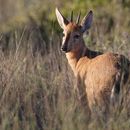en
names in breadcrumbs


The duiker has lived up to 14 years in captivity (Nowak 1991). Pythons have been found dead after being punctured by the duiker's horns during digestion (Kingdon 1982).
Perception Channels: tactile ; chemical
This species is rated to be at "Lower Risk" by the IUCN.
US Federal List: no special status
CITES: no special status
IUCN Red List of Threatened Species: least concern
Duikers dig up and eat potatoes, peanuts, and other crops in agricultural fields (Estes 1991).
In certain African cultures, the horn is used to make pendants that are thought to ward off evil spirits (Kingdon 1982).
Positive Impacts: food
Duikers have been known to eat a wide variety of foods. They generally eat leaves and shoots from bushes, as well as fruits and flowers that drop to the ground due to the feeding of birds, monkeys, and fruit bats in trees. Duikers dig up roots, tubers, and bulbs with their hooves. The resin and bark of trees are occasionally a part of the duiker's diet. They have been known to eat insects, such as caterpillars, cockroaches, and ants. In uncommon instances, duikers have been seen stalking and eating lizards, frogs, rodents, and birds. Water requirements are met from moisture in the vegetation they consume. (Estes 1991, Kingdon 1982)
The gray or common duiker is found in the Sub-Saharan region of Africa from Senegal to Ethiopia. It also ranges from Eastern Africa to the southernmost tip of Africa (Nowak 1991).
Biogeographic Regions: ethiopian (Native )
This speices of duiker is found in areas of central, eastern, and southern Africa which provide sufficient amounts of cover. They inhabit savannas, grasslands, and woodlands. They also live in mountainous regions and are found at higher altitudes than any other African ungulates. They are not found in deserts or densely wooded areas such as the rainforests.
Habitat Regions: tropical ; terrestrial
Terrestrial Biomes: savanna or grassland ; forest ; scrub forest ; mountains
Average lifespan
Status: captivity: 14.3 years.
Average lifespan
Status: captivity: 12.0 years.
The average weights, coloration, and ear size of the gray or common duiker vary with geographic location. Females generally weigh 2-4 kg more than males in a given region. On average, they are 60 cm in height at the shoulder and are 100 cm in length. Males have horns, which are spikes 7-18 cm and are heavily grooved at the base. Females usually do not have horns, but occasionally they may have stunted horns. Ears are 9.5-14.5 cm in length. Longer ears are found on duikers in open, arid habitats. Coloration varies from pale, light colored animals in dry regions, to dark gray colored in moist habitats. Mountain dwelling duikers have longer, thicker coats than duikers living in savannas, forests, and grasslands.
Range mass: 12 to 25 kg.
Average length: 100 cm.
Other Physical Features: endothermic ; homoiothermic; bilateral symmetry
Sexual Dimorphism: female larger; ornamentation
The male and female form a monogamous breeding pair. There is no evidence of a peak breeding period (Estes 1991). Female duikers are known to give birth during all months of the year, and gestation is estimated to last 4-7 months (Kingdon 1982). Females find very secluded, thick cover to give birth. Normally only one young is born, but sometimes there are two. They are defended by both the male and female. The young reach adult size in 6 months and attain sexual maturity in 8-9 months (Nowak 1991).
Range number of offspring: 1 to 2.
Range gestation period: 4.1 to 5.67 months.
Key Reproductive Features: gonochoric/gonochoristic/dioecious (sexes separate); sexual
Average birth mass: 1612 g.
Average number of offspring: 1.
Average age at sexual or reproductive maturity (male)
Sex: male: 255 days.
Average age at sexual or reproductive maturity (female)
Sex: female: 255 days.
Parental Investment: altricial